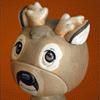
While I was living in Pasadena I was watching a DVD of old Fleischer Superman cartoons, and I got this flash idea of how the flying automobile from "The Bulleteers" might have worked. I decided to make it look like an old engineering drawing, but I feel my hand lettering is very poor. So I cleaned it up in Photoshop, and I added computer lettering. I really like the result, but I figure I could make more improvements.
Of course my original, mad plan was to build a scale model of the darned thing.
Of course my original, mad plan was to build a scale model of the darned thing.
Category Artwork (Traditional) / Fanart
Species Unspecified / Any
Size 763 x 1000px
File Size 289.3 kB
Not really... The original cartoon I believe is dated to 1942. The earliest I date to is late 1956, and I really didn't start drawing like this until 1988. Then I discovered "Furry" Fandom, and look where I'm at now. It's all kind of a fun, time tripping experiment.
2 Things.
One, comsidering the Starfighter's ratio of length and wingspan, this construction actually worked.
Two, about that scale model... I once saw a plan for sale for a remote controled plane. It had a wingspan of 2,5 meter and was on the scale of 1/2, So, that would mean that the original had a wingspan of 5 meter???
Well, I saw the original in the German Museum in Munich. Under the wing of a Junkers Ju52. It was dwarved by the wing alone. It was a one-seater and really had a wingspan of only 5 meters.
One, comsidering the Starfighter's ratio of length and wingspan, this construction actually worked.
Two, about that scale model... I once saw a plan for sale for a remote controled plane. It had a wingspan of 2,5 meter and was on the scale of 1/2, So, that would mean that the original had a wingspan of 5 meter???
Well, I saw the original in the German Museum in Munich. Under the wing of a Junkers Ju52. It was dwarved by the wing alone. It was a one-seater and really had a wingspan of only 5 meters.
"Glamorous Glennis" The first aircraft credited with breaking the Sound Barrier had it's design based on a .50 Caliber bullet. I had to watch the Superman cartoon several times until I could get a look at the rear view of the Bullet Car. The "Drive" seems kind of comical and unusual, as the only means of attaining Thrust is through four "Rocket Tubes" sticking out below the tail fins. Proof that if enough thrust is applied to anything, it'll fly.
Now that you mention it, the Bullet Car's proportions are very close to an F-104 Starfighter. Hmmmm...
Now that you mention it, the Bullet Car's proportions are very close to an F-104 Starfighter. Hmmmm...
Very interesting. Now that bomber from 'Japateurs'* would be interesting too. It was so big its self-defense fighters could launch from the top. The robots from other Fleischer cartoons were really fascinating. If was great to see them in action in CG in Sky Captain and the World of Tomorrow.
*A rather racist wartime cartoon.
*A rather racist wartime cartoon.
Oh! I'll have to go and watch "The Japateurs" again as I don't recall any bomber in it. Yes... I liked the visual effects in Sky Captain and the World of Tomorrow" even though the story was weak. It might be fun to draw up a cut away view of "The Mechanical Monsters" now that I think about it.
Is so huge the air stair is an escalator. It's a streamlined monstrosity. How they would have gotten it back on a runway again at the end is a mystery to me.
Sky Captain might have been less fun if it had been so serious and gritty like they try to make remakes now. The cheese makes it worth watching to me.
Sky Captain might have been less fun if it had been so serious and gritty like they try to make remakes now. The cheese makes it worth watching to me.
Yes and no. Each of the Disney studio and the Fleischer studio had multi-plane cameras for which they got different patents. If you look at the Superman cartoons, for example, you will see references to the patent numbers there. That was more for using models as backgrounds. See, for example, the Color Classic "Play Safe" or the two-reel "Popeye Meets Sindbad" cartoon for outstanding examples. By contrast, the multiplane camera at Disney was more geared toward different layers and depths of cels, "The Old Mill" being the first and Oscar-winning example.
I would be very surprised that Max Fleischer would be in the original Fantasia credits, considering he was working for Paramount, in essence, at the time Fantasia came out in 1940, unless Disney had licensed certain patents.
The major figure involved with Disney's multi-plane efforts was Ubbe Iwerks, who rejoined Disney in the late 30s after his studio went under.
I would be very surprised that Max Fleischer would be in the original Fantasia credits, considering he was working for Paramount, in essence, at the time Fantasia came out in 1940, unless Disney had licensed certain patents.
The major figure involved with Disney's multi-plane efforts was Ubbe Iwerks, who rejoined Disney in the late 30s after his studio went under.
he is there in the credits
the patents Disney obtained where after the invention of the camera Max had. Disney did what anyone would do when they say a great idea, made one themselves. According to Jack Paar (the animator not the standup comedian) Max did work with Disney there was no enmity between them.
Jack Parr was my uncle and was an animator (credited and uncredited) for Disney and Hanna/Barbera
the patents Disney obtained where after the invention of the camera Max had. Disney did what anyone would do when they say a great idea, made one themselves. According to Jack Paar (the animator not the standup comedian) Max did work with Disney there was no enmity between them.
Jack Parr was my uncle and was an animator (credited and uncredited) for Disney and Hanna/Barbera
Actually it was Ub Iwerks that developed the first multi-plane camera. The Fleischer's device was a turn-table with three-dimensional models built on it. The animation cells were held vertically in front of the turn-table when photographed. You could not truck in and out with this set-up, only pan. It was the same thing with Iwerk's set-up.
Disney's multi-plane animation stand, where the animation was shot flat, with backgrounds on different levels behind or in front of it allowed truck ins and outs and pans in different directions instead of just right to left or left to right.
Disney's multi-plane animation stand, where the animation was shot flat, with backgrounds on different levels behind or in front of it allowed truck ins and outs and pans in different directions instead of just right to left or left to right.
What happened was that Paramount Pictures, though which the Fleischer cartoons had been released, had lent the studio money, which in part went to the two feature films the studio made ("Gulliver's Travels" and "Mr. Bug Goes to Town"), and in part in moving the studio from New York to (right-to-work friendly) Miami. There were severe financial strains involved, which were exacerbated when Paramount lost key overseas markets in 1938-1941 because of the war. Finally, Dave Fleischer and Max Fleischer had extremely serious personal differences. Paramount essentially got undated resignations from the two of them, and exercised them in the first quarter of 1942. The studio was eventually reorganized (as Famous Cartoons) and moved back to New York City.
Dave Fleischer took over from Frank Tashlin for a brief time as head of Columbia's Screen Gems cartoon unit, and Max Fleischer continued to dabble in animation, working with the Jam Handy organization to produce the first screen adaptation of "Rudolph the Red Nosed Reindeer."
Dave Fleischer took over from Frank Tashlin for a brief time as head of Columbia's Screen Gems cartoon unit, and Max Fleischer continued to dabble in animation, working with the Jam Handy organization to produce the first screen adaptation of "Rudolph the Red Nosed Reindeer."
Actually, the Superman cartoons were very popular, but were so expensive to make that the Fleischer's were subsidized by Paramount to make them. The Fleischer's were spending anywhere between $30,000 to $50,000 of the parent studio's money on each Superman cartoon, and since you could only get so much per cartoon in rentals, Paramount was loosing money, which is why the studio pulled the plug on the series in 1944. What broke the Fleischer's was the failure of HOPPITY GOES TO TOWN.
The power of imagination? The evil geniuses who built the bullet car must have figured out some sort of inertia dampening field because during the final show down between Superman and the flying automobile, The Man of Steel punches the car and bends it into a 90 Degree angle. (Of course that was all for a visual effect.) Still, ramming the Bullet car into buildings at super-sonic speeds and repeatedly getting violently thrown off course many times would have turned the occupants of the vehicle into bloody goo.
Uh... I guess we shouldn't let the facts get in the way of a good story, eh?
Uh... I guess we shouldn't let the facts get in the way of a good story, eh?
This is one of my favorites of the Fleischer Superman cartoons, along with that one with the Hollow Earth full of Hawk People (in a cave?) and the giant robots doing bank robberies. Seriously, that guy had the moolah to make an army of giant flying fire-spewing robots and decides to use them to rob banks?
Considering a fellow who wears a spotless "Zoot Suit", seemingly untarnished after working for hours in his underground factory, has a pencil thin and pointed "Rapier" mustache, and how he cares more for the lost jewels over capturing a grand prize like Lois Lane, the fellow was obviously not in his right mind.
Ironically, the animators picked the .50 cal bullet for the shape because they had heard that the bullet had been designed for supersonic speed. However, the bullet-car they came up with is not the same as the .50 cal. bullet -- it's the bullet AND the shell casing that contains the powder -- which was never meant to be supersonic or even aerodynamic!
It's really strange that several animators happen to have the same names as other, more famous people. I'd never heard of Jack Paar the animator, but I have heard of Ken Muse; one was a comic strip artist who created the daily gag strip "Wayout" in the 1960s and wrote/illustrated a series of books on cartooning... another Ken Muse was a professional animator whose name showed up in bunch of "Tom & Jerry" cartoons. Anyone have more examples?
I have copies of a lot of Fleicher's shorts & his 'Gulliver's Travels'. I've always enjoyed his work, even the Popeye The Sailor shorts. In many ways he was more a genius than Walt, who was his primary competitor back in those days. Walt was a country boy and his work showed it. Fleicher was city born & bred and his creations showed that as well. Betty Boop is a favorite of mine, and may of his early works had her naked or at least partly so. That was before censorship became king and he loved to push the 'edge' there. Never anything nasty, but always entertaining. He also created CoCo the clown who appeared out of an ink bottle for each cartoon.
We don't have folks like him around anymore in Hollywood. Sad to say.
The bullet car/plane is nicely done, Roy. Your attention to detail has not let you down <grin>.
Mythril
We don't have folks like him around anymore in Hollywood. Sad to say.
The bullet car/plane is nicely done, Roy. Your attention to detail has not let you down <grin>.
Mythril
I had a lot of fun thinking this drawing out. The easy part was figuring the rough mechanics and basing it all on 1930's aircraft and automobile technology, but the engine and jet drive is still in the realm of "Magic." I watched "The Bulleteers" episode at least a dozen times while working on the drawing, and noticed there was a part where Superman punches the Bullet Car and sends it ricocheting off a building, bending the car into a "Boomerang" shape. Now in the "Real" world, that could have been a fatal blow for the machine, which could have broken it in two, but the machine came back for more. ...Just another delightful example of Cartoon "Make Believe" that is integral to a good story.
I'll have to check that out. I remember reading a science fiction story where one of the first humans born in Orbit was orphaned when his Mother was killed by a two ton beam used during the construction of the Space Station. The mass was considered "Weightless," but it still had the inertia of a two ton beam.
I've also been mulling in my head about what would happen if a Mecha picked up a big "Dualie" pickup truck and Body slammed it Judo style. I figure the truck would disintegrate as it's frame is bent by the unusual forces, and the impact might just bend or deform every outside body panel left.
I've also been mulling in my head about what would happen if a Mecha picked up a big "Dualie" pickup truck and Body slammed it Judo style. I figure the truck would disintegrate as it's frame is bent by the unusual forces, and the impact might just bend or deform every outside body panel left.
A great comic/ american manga, Empowered, also deconstructed the usual "throw a car at oponent" by demosntrating that it was way smarter to simply turn on the car and send it at 140 mph. Also, that if you still sinsist in throw it, is much better to just throw the heavy engine than send it enveloped by the soft chasis. And so on. Pretty good comic, Empowered =D

 FA+
FA+





























Comments